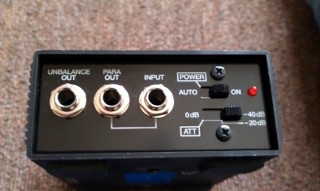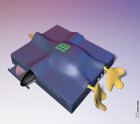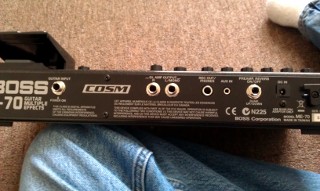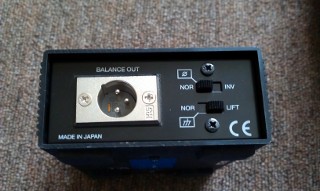How To Set Up A Church Sound
System: Electrical Guitar
Introduction
I wrote this document to hopefully help people set up church sound systems, specifically electric guitars.Electric Guitar
An electric guitar can be a challenging thing
to incorporate into a church worship team. One of the main
issues with incorporating electric guitars into a church worship
team seems to be how to handle its output and sound. There
are different approaches to this. One approach is to use a
direct box to take the electric guitar's output and run it into
the church sound board where the church sound technician(s), if
any, can adjust its output level in relation to the rest of the
sound mix. This is not my preferred method for doing so, but
most churches are too small for the guitarist to use his own
amplifier as a monitor. Another approach is to let the
guitarist use his own amplifier and use a microphone to record the
audio and send it to the sound system for mixing. I will go
over this method first, and then separate issues related to each
method.Impedance
First, impedance is the difference in the resistance to electrical current that is encountered in a circuit when voltage is applied. This may sound weird, but basically there are different circuits used in sound production and they're not compatible. First, microphones are usually low impedance, and they are passive. The microphone becomes part of a circuit and sends a very small signal of millivolts. The output on your amp or effects pedal, if meant to power headphones, is not passive, but active (i.e. drives its own power rather than being part of a power loop like a microphone). The output of an electrical guitar is high impedance because even a single vintage single-coil pickup runs 6.4K ohms, plus potentiometers are 250k and 500k. Passive electrical guitars of all kinds are not the same impedance as a microphone. On top of that, active electrical guitars are also very different in impedance.While there are line-in ports on most, if not all, church sound systems, often you don't see them being utilized. The main reason is that a true XLR cable has a ground to keep stray voltages from causing interference. This is important because long runs from the back of the church to the front (where the praise team is standing or sitting) make the cable runs susceptible to interference. The grounding shields it from interference. The cables use in a guitar are 1/4", and they are not shielded. As such, simply using a 1/4" to XLR adapter that doesn't match impedance not only doesn't adapt the sound on the 1/4" jack to the impedance the sound board is expecting along XLR cables (i.e. like a microphone), it also usually doesn't help shield anything because the ground begins at the adapter and ends at the instrument.
Not adapting impedance often results in complaints like "I had to turn you all the way up" or "I had to turn you all the way down" from the sound technician(s). This is why impedance matching, as performed by a direct box, or DI box, is important. I will detail this below, but please also see the end about an alternative.
As a side comment, acoustic guitars are no different. They are usually active circuits (if they have a battery) or passive, but either way, normally their impedance is not (again) what a sound system expects over XLR cables. I strongly recommend that acoustic guitars also use direct boxes, unless they already have one built in (hint: usually this is when they have an XLR output port on them).
Grounding Warning
I strongly recommend, in light of the amount
of power being used in a church sound system, that everyone use
grounded electronics. I have served at churches where
there is no ground. I've gotten shocked when my lower lip
touched a microphone. A church doesn't want killing or
injuring someone on its conscience or its insurance, so I highly
recommend that everything that can or should be grounded be
grounded.
So for instance, if you're being shocked by a
microphone, you need to check the microphone cable and make sure
all three wires (the third being ground) are good all the way
from the microphone to the sound board. That and also
consider using a pop filter (the foam things that cover
microphones), which has the added benefit of color (so you know
whose microphone is whose, etc) and softening the loud
consonants (plosives) from singers.
Electric Guitar and a Direct Box
With this method, the guitarist plugs his guitar into his effects box and then runs a cable from the port that gives him a simulation of having an amplifier into a direct box (in the case of my Boss ME-70, this is labeled "REC OUT/PHONES"), or a Line Out from his amplifier into a direct box (assuming he can bring an amplifier to church; otherwise, the best solution here is to buy something that converts his sound on his effects chain into something you can record or plug your headphones into).
The reason for this is beause the sound board is expecting sound that is ready to be included into the mix, which is not the same as the amplifier output, for an amplifier is going to add its own sound coloring to the guitar signal it receives. The Boss ME-50 and ME-70 Line Out / Headphones jacks include sort of a simulation of an amplifier, so this is very well suited for the sound mix.
As for the other features, the Amp Left/Right outputs are for one (using Left) or two (using Left and Right) amplifiers. A guitarist may be able to run his own amplifier and use it as a monitor, but if this is the case, a better approach would be to simply use a microphone to record the sound from the amplifier, if possible.
The direct box itself may or may not have
several features, and I am going to explain them here.
Second, the top right switch is for switching the output signal on pins A and B. Most sound systems will not need this, so you should probably leave this switch, if you have it, in "NOR" for "normal".
Third, you have the ground switch. It is the switch on the lower right. This is "NOR" for "normal" and "LIFT" for "lift". I highly recommend that it be left in "NOR" for normal so that it is grounded. It is important that you have a ground because it is much safer. Without a ground, you could get electrocuted ("shocked"). Now, that being said, when I wrote this I was playing guitar at a church that had horrible grounding (basically, no grounding). I had to use "LIFT" to keep it ungrounded because I experienced all kinds of weird problems with it when it was in "NOR". However, this is NOT SAFE and I do NOT recommend that anyone use "LIFT": if your church has grounding problems, you need to fix them so you don't kill anyone.

On the other side of this direct box are a few important features. First, there is INPUT. You plug the guitarist's Line Out or headphones out into this. If you plug the guitar directly into this, you will only get their guitar's signal (useful for acoustic-electric guitars and electric bass but not for an electric guitarist who is going to use effects).
Second, there is "PARA OUT". This means parallel output, i.e. a way to take the output being received on the INPUT jack and send it to another device. I have never personally needed to use this, but it could be used for headphones or a small keyboard amp or self-powered monitor. Now, that being said, if you have bad cables, this could cause problems, so check your cables periodically.
Third, there is UNBALANCE OUT. This is a way to take the unbalanced output of what the direct box is doing and run it to something that does not have a microphone cable (XLR) such as some old sound boards that have only 1/4" jacks. Most people are not going to need this.
Fourth, there is the power button. Most direct boxes can be run on phantom power, which is how some sound boards run power to certain devices like monitors and condenser microphones. On these, using "AUTO" will let it use the phantom power rather than its own internal 9 volt battery. In my experience, I've had issues with this as well, due to a poor church sound system, so I switch mine to "ON" so that it uses its own 9 volt battery. However, most direct boxes aren't intended to be opened every weekend to check the battery power, so keep in mind you should try not to open it up all the time.
If your direct box does not have a battery or a power switch, it probably uses phantom power from the sound board. However, keep in mind that phantom power can be DANGEROUS to use with a sound board if the wires are not good and/or the grounding is not good. You could KILL someone if you ignore my warnings about ground and phantom power, so be very careful!
Last, there is the "ATT" switch on the right bottom. This is for attenuation. This means you can adjust how much signal the sound board is receiving. You can set it to 0 dB, which means the sound board gets the guitar's input at the same power level it is being received in. Then here is -20dB and -40dB, which lower the volume being sent to the sound board. At the time I wrote this, I had to use -40dB so that the sound board could handle my sound. Basically, if the sound technician(s) is complaining that your sound is too high, try -20dB first, and if that's not enough reduction, try -40dB.
Keep in mind that while some sound boards have "LINE IN" jacks for connecting line in signals like this and computers, CD players, etc, I would not recommend running a long cable that's LINE IN, which is usually a 1.4" jack. Why? Because XLR cables are grounded and shielded, so long lengths of them are less of a problem because they resist interference better. Running a long unbalanced (1/4") cable is not good because they are not shielded so they are going to have more problems with interference sneaking into the sound.
Now one issue you can run into when using a guitar into a direct box and into the church sound board deals with monitors. If you have only one monitor signal, your problem will come in when everyone who has a monitor near them prefers a different mix. On most sound boards, individual signals (microphones, guitars, pianos, etc) can be adjusted in the monitor to suite the person using the monitor, but the problem here is that if everyone prefers to hear different things in their monitor then a sound technician can get overwhelmed with everyone saying something different. Usually this works out that the electric guitarist complains that he cannot hear himself in the monitor, the singers complain that there's too much guitar, the piano player complains that there is too much guitar, the drummer complains that there is too little guitar, etc. I recommend that if you have only one monitor output that you simply put all instruments at the same monitor level and tell them to "just deal with it", because you will never get everyone to be happy with the level of individual signals.
If you have more than one monitor signal, you may be in luck, as (for example) you can run one monitor signal to the singers and worship leader, and adjust it to their liking, while you run one monitor to those playing instruments. However, you could experience the same problem all over again, as no two people like the same monitor setup.
This is why allowing instrument players to have their own amplifier and/or monitor works great because then they can set it how they want it, and/or at least hear themselves. Usually the best method is to have one monitor output for the church sound mix, or just singers and piano or keyboard, for everyone, and then allow the other instrument players to use their own amp, this way they can hear the rest of the worship team but also hear themselves. See the next section.
Electric Guitar, an Amp, and a Microphone
This is the best of both worlds. If
your electric guitar player has a small enough amplifier (no
more than 15 watts is my recommendation for tube amplifiers, and
50 watts for solid state amplifiers), you can use a condenser
microphone that is designed to be close to what it is recording
and place this right on the guitarist's amplifier. Most
these have attenuation controls like the direct box above, so
you can use -20dB or -40dB to make the sound volume
usable. Your guitar player is happy beause he can hear
himself (and an amplifier, especially tube, is much more
responsive and expressive), and you get a much better quality
sound into the sound board. With this method, no direct
box is required, and the guitarist plugs his effects chain or
Amp Out (ME-70) into his amplifier.
There are only a few minor things to keep in
mind with this method. The first is that such a guitar
player needs an amplifier stand so that the amplifier is off the
ground and pointed at his face so he can hear it. The
second is that the guitarist needs to put the volume of his amp
at an agreed-upon setting so that he does not go deaf and/or
annoy others around him (singers, other instruments). The
third is that you need a boom microphone stand so that you can
place the condenser microphone directly on and facing the
amplifier.
I used this exact setup while leading worship
in Korea, and it worked out great because they already had an
amp stand and a boom mic stand. My amp faced me, I was in
the center of the platform, and I had a microphone close to my
face (also on boom stand). It is important to use
boom stands because these allow you to place a microphone almost
anywhere you want but it gives the singer / instrumentalist more
space so they don't run into the stand or hit the stand with
something.
That being said, not all churches are
acoustically favorable to using an amplifier. First, if
there is no carpet, especially not on the platform, there is
going to be a lot more echo. Second, if walls are not
sound insulated, these will also echo. Even unpadded
wooden pews and/or unpadded metal chairs will echo. In an
acoustically poor auditorium everyone including even the guitar
player is going to complain about how loud the amplifier is
because of all the echo. It's like speaking while walking
in a stairwell: soft is easier to hear, but loud talking is
actually harder to hear because of all the echo. Not all
churches have the money to spend on insulating their auditorium,
so this presents a problem.
I personally recommend that, in an
acoustically poor auditorium, a guitar player uses Line Out and
either a monitor or even a monitor headphone. However, the
problem with a monitor headphone is that it can make it
difficult for the guitarist to hear the rest of the worship
team, which could result in having a harder time staying in
rhythm, knowing where in the song the worship team is, etc.
Alternative: Electric Guitar, Direct Box, and Amp
An alternative where space or equipment does
not permit is to use both an amp as a monitor for the guitarist
or musician, and a direct box for the sound system. This
gives a sort of hybrid solution.
First, for some amplifiers that have an extra
output to run a self-powered extra cabinet, you can plug this
output through a direct box into an XLR jack. It is
important to say that it's for a self-powered cabinet here,
because running an amplifier-level high-power line into a direct
box is either going to require you to have one that can drop the
output level (like the Boss direct box I use, above), or it's
going to damage things.
Second, for some musicians (like myself) who
run a multi-effects pedal, you have a Line Out for
headphones. This usually (ME-50 and some others) comes
with an amplifier simulation on the line so that it sounds more
"organic" to the church sound system. On others (ME-70) it
is selectable based on the specific effect being used (so that's
important to keep in mind because if you're not using an amp
simulator in the selected patch, you could end up with a very
"dry" sounding production). At this point, like with my
ME-70, i could run a small amp through "Amp Out" just so I can
hear myself, and the church sound technician could control my
level that comes out of the sound board.
The Bane Of Church Audio
Church Audio is often a point of conflict
and frustration among the congregation, the church's leadership,
and its worship team members. My advice is to use a direct
box (electric guitar players) to try to make things easier on
your church audio technician.





